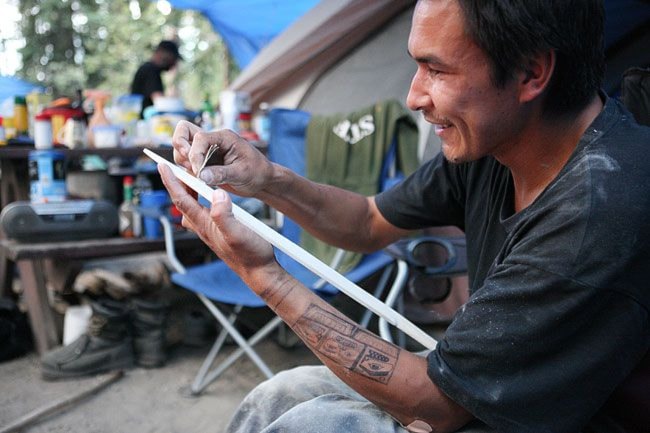Terrance Clark’s setup was elaborate.
A tall ship’s worth of sail-sized tarps surrounded and protected his site. Hung impossibly high over his spacious four-person tent and covered with a riot of graffiti, they billowed in the wind with a Jolly Roger’s implicit challenge.
His picnic table served as a kitchen counter, stacked with cups and bowls, spatulas and whisks.
The other long-term campers on neighbouring sites at the Robert Service Campground this summer had equally impressive homes. Pots and pans hung in neat rows on pegboards nailed to trees. Firewood was stacked carefully beneath roughshod tables and benches fashioned from the same material.
But Clark’s site had one key difference. Next to his kitchenwares were collections of chisels, knives, brushes, markers and spray cans.
Clark is a talented First Nation artist whose craft blends traditional Chilkat artwork with modern graffiti and street style. He spent the summer living at the campground with a collection of other long-term campers, about half of them - like him - on social assistance.
The campground is one place where people struggling with low or non-existent income end up living over the summer. Government social assistance programs pay out a living allowance of $881 a month. The campground charges social assistance clients $850 a month, in contrast to the $540 per month that non-assistance campers have to pay.
Over the summer, the number of social assistance clients at the campground varied between five and 12. With October winds blowing and winter around the corner, many of those clients will be forced to search elsewhere for shelter and about a dozen will end up moving into motels, according to the Department of Health and Social Services.
But while the weather was warm, a small community of campers did its best to keep things on an even keel. Brought together by circumstance, they would cook and eat together, and keep an eye on each other.
Clark did the Sundog Carving Studio’s hollow canoe-carving program in 2009. He also studied at the Freda Diesing School of Northwest Coast Art, and has honed his skills to perfection.
One mask that he’s been working at on and off for a couple of years will fetch more than $2,500 when it’s finished. An RCMP officer in town who knows Clark offered to buy it when it’s done.
He does a lot of his work at the campground, sitting next to his or his neighbours’ campfires, patiently sanding or sketching or carving life into his work.
The scent of woodsmoke mingles with roasting hot dogs, as the campers traded stories, laughter and drinks.
But like other long-term campers, Clark also has his demons.
“I don’t know what any girl would want with me. I’m an alcoholic who lives in a campground,” he says.
His struggles with booze make holding down a full-time job difficult. At its worst, it sometimes undermines his artwork.
“One time I was with some buddies and I sold a $1,400 Swiss chisel set on the street for $200 because we were desperate to get drunk,” he said.
But there is more to Clark than his art and his booze. He has a nine-year-old son, Kobe, whom he adores. Kobe sometimes comes to visit Clark in the campground, and they practise graffiti work together on Clark’s sprawling tarps.
“He’s younger than some of my tags around town,” Clark says, smiling.
Clark also volunteers at Blood Ties Four Directions, sometimes making sandwiches. Other times he builds drug kits for crack addicts. Like clean needles for IV users, the kits are distributed through the organization’s outreach van as a harm reduction measure.
Volunteering is one way for Clark to reduce his community service hours, which were ordered after he got arrested for spraying graffiti along the Millennium Trail.
“We got three cans of spray paint, a whole bunch of booze and we just went nuts.”
Volunteering has been a surprising and enlightening experience for him, he says.
“It’s kind of a crazy place to be. You learn so much about drugs and shit. Like how they include a piece of plastic tube with the crack kits so users don’t burn their lips on the pipes and spread hep. C and stuff from sharing the pipes,” he said.
He’s trying his best to turn things around, he says.
Like most communities, the campground wasn’t without its frictions. Sometimes tempers would flare, especially as more beer cans were emptied.
It wasn’t uncommon for parties to get carried away. Shouting and raucous laughter echoed through the trees on most weekend evenings. Occasionally the RCMP would end up getting involved.
Towards the end of the summer, Clark had a falling out with another camper and decided to leave.
In a rage, he tore down his elaborate tarps and tents and burned them. He packed up his belongings and left. He bounced around the city for a few weeks after leaving the campground, eventually moving back into his mother’s apartment, where he sleeps on a thin mattress on the floor.
He doesn’t like it, he says, but the stability helped him land a job in the kitchen at a local hotel restaurant.
He’d rather be in his own place, somewhere with the campground’s freedom and independence, but his mom’s apartment is a roof over his head and a place to wash his hotel work clothes, so he says he’ll stick it out until he can find something better or maybe save up enough to rent a place of his own.
Contact Jesse Winter at
jessew@yukon-news.com
